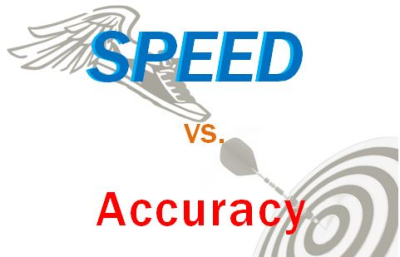The CFO’s Dilemma: Speed Or Accuracy?

We have been trained to make certain our debits equal credits and our facts are indeed facts. We have been taught that numbers speak louder than words and to be suspicious when the right answer isn’t completely clear. It’s no wonder finance professionals have developed a reputation of being a little late to the party and hard to communicate with.
In an age when a wish today ends up on our doorstep tomorrow where does that leave a whole industry that methodically and meticulously creates a near perfect product that is often delivered too late to create much value?
It leaves us behind. With so much change facing us in the coming months, being left behind may not be a temporary condition for your company.
Here are some steps to help CFO’s get back in front.
1. Create a list of products and services (when “products” is used during the rest of this article it refers to both products and services) our teams provide to our consumers; including customers, the Board, company colleagues, vendors and government and other agencies/organizations.
Normally, this is no trivial task. It’s uncanny how aware our sale’s staff are of every product we offer the market, but our CFO teams frequently don’t think of our work as a product. Having a product mindset is the first step in overcoming The CFO dilemma: Speed or Accuracy?
2. Develop a strong understanding of how critical the products we deliver are to business survival and profitable growth.
The best way to do this is to ask the consumer of our products how they fit into their needs and how important they are to them. For some older companies this can be a discouraging but eye-opening exercise. There is an excellent chance some of the products the finance team is providing are no longer being used or their use so trivial the cost to create them far exceeds their value to the consumer.
Next, categorize the products on a 1-5 basis, with 1 being the least important and 5 being the most important.
An added benefit to this step comes when this question is answered: Is there a better way for us to create or deliver this product. Simple answers like providing an electronic version of a report versus hard copies or having a customer enter data directly online rather than sending in a form to be re-keyed may provide significant benefits.
3. Determine the speed/accuracy trade-off for the products you provide.
Here is where CFOs earn our paycheck. Starting with the most important products recorded in step 2 analyze the impact time has on the value of the product. Some products may have a steep or even a step function decline in value due to time (missing deadlines on filings, for example). It’s more than likely these products are managed well because the penalties associated with time delays are very transparent.
Products that deteriorate more gradually (completing credit analysis requests, preparing and sending customer invoices, reporting results, for example) seem to be more problematic. This is especially evident when an internal time standard has not been set, making the cost of time delays less visible.
Add the time value decay to each product identified in step 2. Be practical here. You may not have a time decay formula so a subjective measure is ok to begin with. The key is to create a means to compare product time value decay on a relative basis.

4. Speed up. How does speed impact accuracy? If we are frustrated some of our great products aren’t being used effectively, it may be due to time induced value decay. Our products are simply delivered too late to be useful. The most common example of this is in the reporting of financial results. No executive looks forward to studying last month’s results half way through the following month. Most are already executing their plans for the coming month – the previous month is like reading yesterday’s newspaper. When was the last time you read yesterday’s newspaper?
Compare the delivery dates on our products to their decay in value from the passing of time. If the delivery dates on important products are reducing their value, we have two levers to pull to improve the speed of delivery. Both are useful.
First, we can redesign the processes used to create the product and produce it quicker. CFO.University’s A Guide to Financial Process Redesign offers the tool and instructions to do this. If you already have a process redesign tool in place at your company, take advantage of it.
Second, loosen up the specs on the product we are producing. No, this isn’t committing financial heresy. It’s a practical approach to 500 years of expecting perfection in our products. The problem with perfection is it frequently takes too much time. Even worse, is this quote from Salvador Dali, “Have no fear of perfection - you’ll never reach it.”
How do we loosen our product specs while maintaining our reputation of accuracy? Take a lesson from step 1 above, have our consumers define accuracy, not ourselves or our staff. These discussions will yield two benefits. We will enhance the understanding of our consumer’s needs and, it’s almost a given, the specs our consumers define will be less “perfect” than our own.
Conclusion
Don’t get caught in the trap of telling consumers what they will get and when they get will it. Catch the habit of learning what they need from our team and when they need it.
By redesigning our processes and being accurate “enough”, but not perfect, we will simplify and speed up the creation of our products and drive more value into our companies.
Identify your path to CFO success by taking our CFO Readiness Assessmentᵀᴹ.
Become a Member today and get 30% off on-demand courses and tools!
For the most up to date and relevant accounting, finance, treasury and leadership headlines all in one place subscribe to The Balanced Digest.
Follow us on Linkedin!
